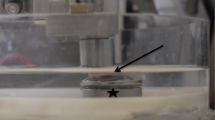Abstract
Introduction: Arthroscopic methods in treatment of chondral defects aim to get smooth cartilage surfaces. Mechanical and thermal methods are used. Often the clinical results are poor or moderate. The treatment of chondral defects by using a hydro jet is an innovative measure. This study was aimed to evaluate the quality of the chondral surfaces after mechanical, thermal and hydro jet treatments in an in vitro scanning electron microscopy (SEM) study. Materials and methods: Femoral osteochondral pieces of the lateral condyle were obtained intraoperatively from patients undergoing total knee arthroplasty for primary knee OA. Partial-thickness cartilage degree II defects were smoothed by a mechanical shaver, bipolar radio frequency energy (RF) and hydro jet (84.1 KPa). SEM was carried out to evaluate the effects of the treatment. Results: Mechanical shaving produces a rough surface with groves and open lying collagen fibers. The surface, after bipolar cool ablation (coablation) was also uneven. The matrix was destroyed by massive vacuolization. Hydro jet treatment produces a relatively smooth surface without open lying collagen fibers. Conclusion: It is not possible to produce even surfaces by mechanical shaving or bipolar treatment. Hydro jet treatment allows a precise cutting which causes a relatively smooth chondral surface.



Similar content being viewed by others
References
Brittberg M, Aglietti P, Gambardella R, Hangody L, Hauselmann HJ, Jakob RP, Levine D, Lohmander S, Mandelbaum BR, Peterson L, Staubli HU (2000) ICRS Cartilage injury evaluation package. In: 3th ICRS meeting Göteborg, Sweden
Gardner DL, Salter DM, Oates K (1997) Advances in the microscopy od osteoarthritis. Microscopy Res Techn 37:245–270
Grifka J, Boenke S, Schreiner C, Lohnert J (1994) Significance of laser treatment in arthroscopic therapy of degenerative gonarthritis. A prospective, randomised clinical study and experimental research. Knee Surg Sports Traumatol Artrosc 2:88–93
Hunziker EB (2001) Articular cartilage repair: basic science and clinical progress: a review of current status and prospects. Osteoarthritis Cartilage 10:432–463
Kim HK, Moran ME, Salter RB (1991) The potential for regeneration of articular cartilage in defects created by chondral shaving and subchondral abrasion. An experimental investigation in rabbits. J Bone Joint Surg Am 73:1301–1315
Lee EW, Paulos LE, Warren RF (2002) Complications of thermal energy in knee surgery—part II. Clin Sports Med 21:753–763
Lu Y, Edwards RB, Cole BJ, Markel MD (2001) Thermal chondroplasty with radiofrequency energy. An in vitro comparison of bipolar and monopolar radiofrequency devices. Am J Sports Med 29:42–49
Lu Y, Hayashi K, Hecht P, Fanton GS, Thabit III G, Colley AJ, Edwards RB, Markel MD (2000) The effect of monopolar radiofrequency energy on partial-thickness defects of articular cartilage. Arthroscopy 16:527–536
Lübbers C, Siebert WE (1997) Holmium:YAG-laser-assisted arthroscopy versus conventional methods for treatment of the knee. Two-year results of a prospective study. Knee Surg Sports Traumatol Arthrosc 5:168–175
Moseley JB, O’Malley KO, Petersen NJ, Menke TJ, Brody BA, Kuykendall DH, Hollingsworth JC (2002) A controlled trial of arthroscopic surgery for osteoarthritis of the knee. N Engl J Med 347:81–88
Owens BD, Stickles BJ, Balikian P, Busconi BD (2002) Prospective analysis of radiofrequency versus mechanical debridement of isolated patellar chondral lesions. Arthroscopy 18:151–155
Sclamberg SG, Vangsness CT (2002) Laser-assisted chondroplasty. Clin Sports Med 21:687–691
Shannon FJ, Devitt AT, Poynton AR, Fitzpatrick P, Walsh MG (2001) Short-term benifit of arthroscopic washout in degenerative arthritis. Int Orthop 25:242–245
Spahn G, Wittig R (2002) Short-term effects of different arthroscopic techniques in treatment of chondral defects (Shaving, Coablation, and Microfracturing). Eur J Trauma 6:349–354
Spivak JM, Grande DA, Ben-Yishay A, Menche DS, Pitman MI (1992) The effect of low-level Nd:YAG laser energy on adult articular cartilage in vitro. Arthroscopy 8:36–43
Stein DT, Ricciardi CA, Viehe T (2002) The effectiveness of the use of electrocautery with chondroplasty in treating chondromalacic lesions: a randomized prospective study. Arthroscopy 18:190–193
Turner AS, Tippett JW, Powers BE, Dewell RD, Mallinckrodt CH (1998) Radiofrequency (electrosurgical) ablation of articular cartilage: a study in sheep. Arthroscopy 14:585–591
Author information
Authors and Affiliations
Corresponding author
Rights and permissions
About this article
Cite this article
Spahn, G., Fröber, R. & Linß, W. Treatment of chondral defects by hydro jet. Results of a preliminary scanning electron microscopic evaluation. Arch Orthop Trauma Surg 126, 223–227 (2006). https://doi.org/10.1007/s00402-005-0002-8
Received:
Published:
Issue Date:
DOI: https://doi.org/10.1007/s00402-005-0002-8




